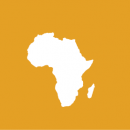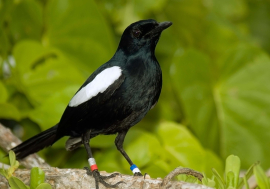Africa Wired
ATM-operated water dispensers bring safe water to poor communities
By Eleni Mourdoukoutas
An automated teller machine (ATM) is the last piece of technology the residents of Mathare expected to see in their informal settlement in Kenya’s capital, Nairobi, especially one that dispenses water, not money. However, ATM-operated water dispensers are starting to pop up across the community, to the delight of the residents.
The ‘water ATMs’ in Mathare work in a similar way as their traditional counterparts that dispense cash. Patrons use smart cards that can be easily topped up at a local kiosk or through a mobile phone, and simply swipe the cards at the ATM-style device.
The water that flows from the tap into jerry cans brought by the customers is up to 100 times cheaper than that from private vendors. It costs only half a Kenyan shilling (less than half a US cent) for 20 litres of water and is guaranteed to be clean and safe to drink. The public-private partnership that spawned the initiative, between the Nairobi Water and Sewerage Company and the Danish engineering firm Grundfos is the first of its kind in a peri-urban area.
Maintaining security is typically the primary challenge to the success of water dispensers in informal settlements, a task this programme has allocated to groups of young people living in the community. They are responsible for ensuring that it is safe at all hours of the day for members of the community to draw water from the four dispensers that have thus far been installed. In informal settlements such as Mathare, residents are often unable to take advantage of amenities offered 24 hours a day due to security concerns, but because of the community’s own security arrangements, the water can be drawn at any time, day or night.
In this way, the system offers greater safety and freedom to the residents. “It ensures that the people in the informal settlements have direct control over their water supply,” says Phillip Gichuki, the managing director of the Nairobi Water and Sewerage Company. In exchange, these community-based security groups receive 40% of Ksh25 (about 25 US cents) garnered for every cubic metre of water.
The youths also keep the water points clean and prevent vandals from tampering with the devices in a city where illegal car wash operations are rampant. In the absence of security, the main pipes supplying fresh water to the city are punctured to divert water to these illegal car wash setups. After use, the pipes are left to spill out until the reserves are depleted. This leads to widespread water shortages in many parts of the city.
Now that the new dispensers have provided an alternative water supply that is easily accessible and affordable, as well as security, those who were conducting illegal carwashes have been forced to collect the water they need legally from the taps instead of destroying valuable pipelines.
The implementation of the ATM water dispenser has not been without challenges. The system features a single tap with water flowing at a slow rate, which results in long queues. Residents report that it can take up to two minutes to fill a 20-litre container.
Grundfos, which is also providing technical support, is working to increase the water pressure on the taps to increase the speed of the water flow, a measure that is easy and not so costly, according to the company’s director of global partnerships, Rasoul Mikkelsen.
One of the greatest assets of this technology in a settlement like Mathare is its ability to track revenue collection, which has always been a challenge to the Nairobi Water and Sewerage Company. Installing an internal system in which no cash is physically exchanged helps to track monies collected more reliably, transparently and efficiently.
So what’s next on the agenda for the ATM-water dispenser?
Mr. Gichuki says the Nairobi Water and Sewerage Company has so far identified 611 more points to install the dispensers and aims to eventually install one every 100 metres throughout the city, especially within the informal settlements.
There are also plans to extent the technology to the rest of Africa. “There are already many potential partners from other African countries who have shown interest in the project,” Mr. Mikkelsen told Africa Renewal. Already, the company has signed agreements to install the ATM water dispensers in Burkina Faso, Ghana, Mali, Niger and Tanzania.
“Ultimately, the project will have a huge positive impact on health. It is an affordable system with sustainable, good quality water,” says Mr. Mikkelsen.
New phone technology to help fight river blindness
By Pavithra Rao
Using the popular iPhone smartphone, researchers at US-based Stanford University have created a simple, portable and inexpensive diagnostic tool to diagnose river blindness, a tropical disease caused by parasitic worm larvae from an infected fly.
An easy-to-set-up microscope called CellScope Loa is attached to an iPhone, making it possible to drop a patient’s blood into the microscope’s compartment for examination.
Every year, according to the World Health Organization (WHO), more than 18 million people in Africa and other parts of the world are affected by river blindness after being bitten by the Simulium fly. This fly, found in parts of Africa, the Middle East and South America, can easily be dismissed as an ordinary pesky insect. But by simply biting the skin, an infected fly can deposit parasitic worm larvae into the bloodstream. An infected person may suffer a litany of skin problems and, in the worst cases, blindness.
According to WHO, the Simulium fly is usually found swarming around rivers in remote areas and can carry worm larvae that cause a disease called onchocerciasis, commonly known as river blindness. This in turn causes spots on the skin that can resemble the rough skin of a lizard, as well as intense, almost unbearable itching when the hundreds of larvae nestled within the body die.
However, the most serious damage onchocerciasis can cause is damage to the optic nerve, often resulting in permanent loss of vision. According to WHO, this is the second most common infectious cause of blindness globally. No vaccines exist against the disease yet and patients must take the prescribed medication twice a year for 15 years. Every year pharmaceutical company Merck, WHO and other partners organize a donation programme in which the drug Mectizan is given to river blindness patients. Similar donation programmes in Ethiopia, Nigeria, Sudan and Uganda, among other countries, have been carried out to cure millions of those affected.
Unfortunately, many of these programmes have recently been halted because the drug may pose a risk to patients who suffer from two other parasitic diseases that are also commonly caused by insects found by rivers and are often mistaken for river blindness: lymphatic filariasis (also known as elephantiasis) and loaiasis, caused by the Loa loa worm.
Though Mectizan kills the worms that cause all three diseases, it can cause harm to patients who have too many Loa loa worms in their bloodstream by wiping them all out at once, causing haemorrhaging of the brain, according to WHO. The CellScope Loa was created to avoid the risk of misdiagnosis.
Lab technicians can examine blood smears and manually identify and count the worms, a process that can take most of a day. Given the number of patients to be tested, this is very time-consuming and often impractical.
Once the CellScope Loa—invented by Stanford University researchers Thomas Nutman and Dan Fletcher—is attached to an iPhone, a patient’s blood can be dropped into the microscope’s compartment for testing. Through use of the iPhone’s internal camera, results of the test can be obtained within two minutes and can include the number of Loa loa worms present in the sample. Based on this procedure, it can be determined whether medication for river blindness needs be given to the infected patient.
The microscope can save precious time and because it works with a prompt-based interface, telling the user the exact steps to take, human error is minimized.
The Stanford University programme to manufacture these microscopes is being funded by the Bill and Melinda Gates Foundation, the US Agency for International Development and the Blum Center for Developing Economies at the University of California Berkeley.
The researchers are currently testing the devices and creating approximately 40 more. So far the results have been encouraging. An initial test was conducted in Cameroon. The second batch of microscopes is being tested in central Africa.
If future experiments with the smartphone microscope continue to produce accurate results, perhaps there is a future in point-of-care diagnoses, especially of tropical diseases.
“It demonstrates what technology can do to help fill a void for populations that are suffering from terrible, but treatable, diseases,” says Mr. Fletcher.























